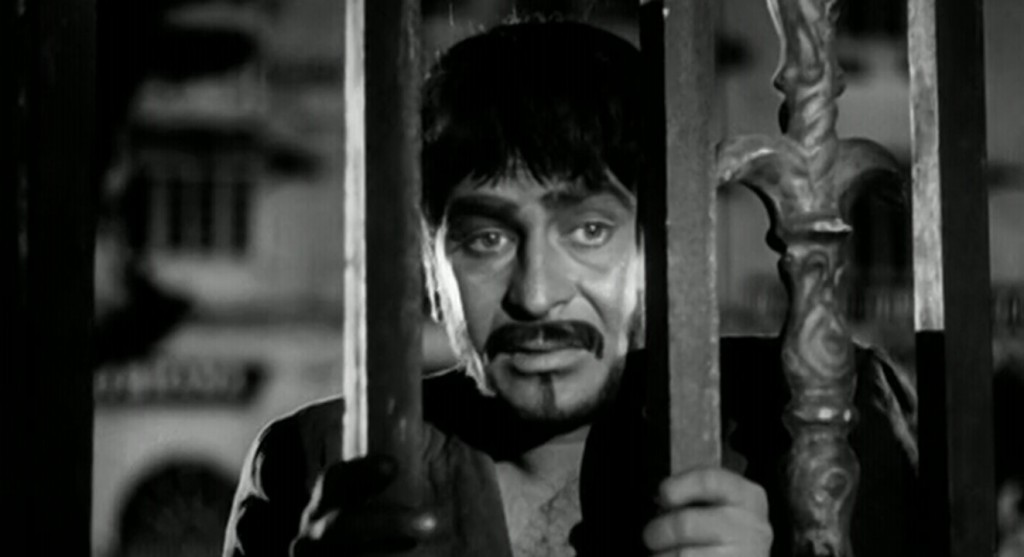A poor, naive and lost villager (Raj Kapoor), who has come to Calcutta, is looking for water to drink. In the midst of his desperate search, he enters an apartment block unwittingly, where he is mistaken for a thief and finds himself drawn into a vortex of corruption and mass hysteria. As he goes from flat to flat through the night, hiding and trying to evade arrest, he discovers behind their closed doors just how respectable and morally upright the so called middle-class, urban dwellers really are …
Jagte Raho, set over a single night’s events in a middle class housing society in Calcutta, is a brilliant comical yet highly critical take on the hypocrisies of Bengali (and Indian) middle class life. The film is written and directed by legendary Bengali actor-director Sombhu Mitra, who was specially invited by Raj Kapoor to helm the film, and co-directed with Amit Maitra. Mitra is regarded as one of most significant figures of 20th century Indian Theatre and is considered among the greatest Bengali stage actors after Sisir Bhaduri, along with Ajitesh Bandhopadhyay and Utpal Dutt. The film also has a Bengali version, Ek Din Ratre, with some changes in cast, etc. For instance, Motilal’s role in the Hindi version is enacted by the great Chhabi Biswas in the Bengali version. Ek Din Ratre went on to win the Certificate of Merit at the 4th edition of the National Film Awards.
Jagte Raho shows Mitra’s pre-occupation with social justice and is a Chaplinesque denunciation of the cruel and entitled petit-bourgeois, who will not even offer a glass of water to a poor peasant, all alone and lost by night, in Calcutta. Like other films of the period – Do Bhiga Zamin (1953), Naukri (1954) and Shree 420 (1955) the film looks at the city as a cold and heartless nightmare. In fact, the opening images of the film are rather similar to the first impressions of Bombay that we see in Shree 420 – the ‘closed’ nature of city life as placed in opposition to the ‘openness’ and simplicity of village life, where everyone knows everyone else: an allegory to the inhuman nature of the city.
Jagte Raho is also an allegoric film about darkness and light, where darkness is the cloak of respectability under which a city supposedly sleeps but in effect thrashes around in the throes of crime and evil – a civilization gone to seed. It seems a night without end, but like always, there is an end, the coming of a dawn at which the peasant discovers that the terrible darkness of the night is only half the truth but out of the suffocating darkness itself shall be born the dawn of a new day of truth, honesty, empathy and justice.
The device of having the peasant run into an apartment block and then having to move from flat to flat to avoid being discovered is an ingenious device as we move from one milieu to another, while also giving the film a sense of urgency and movement. The irony of the film is that while he is thought to be a thief and is chased by the so called righteous petit-bourgeois, what he sees in the flats are far bigger crimes – moral, hypocritical and physical, committed by these ‘respectable’ people behind the four walls of their homes.
To many, Jagte Raho is perhaps Raj Kapoor’s best films. The film certainly sees one of Raj Kapoor’s most remembered and iconic performances as perhaps the best from his Chaplin inspired roles, Awara and Shree 420 notwithstanding. Quoting the British film critic, Geoff Brown: “Kapoor’s character is cut from Chaplin’s cloth. He starts out sharing food with a dog, squatting on the pavement, and spends most of the filma cting in pantomime, darting in and out of rooms, hiding in a drum, shinnying down a drainpipe, periodically pursued by a lively crowd of residents wielding anything from sticks to stringless tennis rackets. The result is one of Kapoor’s most diverting films.”
Fine though Kapoor is, the scene stealer (as usual) has to be Motilal, playing the role of a drunk debauch with wicked relish. Fine support comes from the rest of the ensemble cast.
The other highlight of the film is undoubtedly Salil Chowdhury’s fine musical score. Zindagi Khwab Hai, the haunting Jago Mohan Pyare and the robust Punjabi Bhangra song Main Koi Jhoot Bholeya are easily the standout numbers of the film. An interesting aside: Shailendra convinced Salil Chowdhury to compose Aaja Re Pardesi from Madhumati (1958) from a piece of music used at the climax of Jagte Raho even though initially, Bimal Roy opposed the move. The rest (as they always say) is history!
Jagte Raho, sadly, also sees the last appearance of Raj Kapoor and Nargis together on the silver screen. Though Chori Chori (1956) was their last film as a lead couple, here she makes an important cameo at the end of Jagte Raho and perhaps it is fitting that she is finally the woman, who quenches Raj Kapoor’s thirst and thus ends the film with an element of romantic humanism.
A shortened version for the International market of Jagte Raho (115 minutes instead of 149) went on to win the Grand Prix at the prestigious Karlovy Vary Film Festival, Czechoslovakia, in its 1957 edition.
Jagte Raho is one of those rare films which have not just stood the test of time but is, in fact, even more relevant in today’s times. And that is a surefire sign of the film being a classic.
Hindi, Comedy, Drama, Black & White


